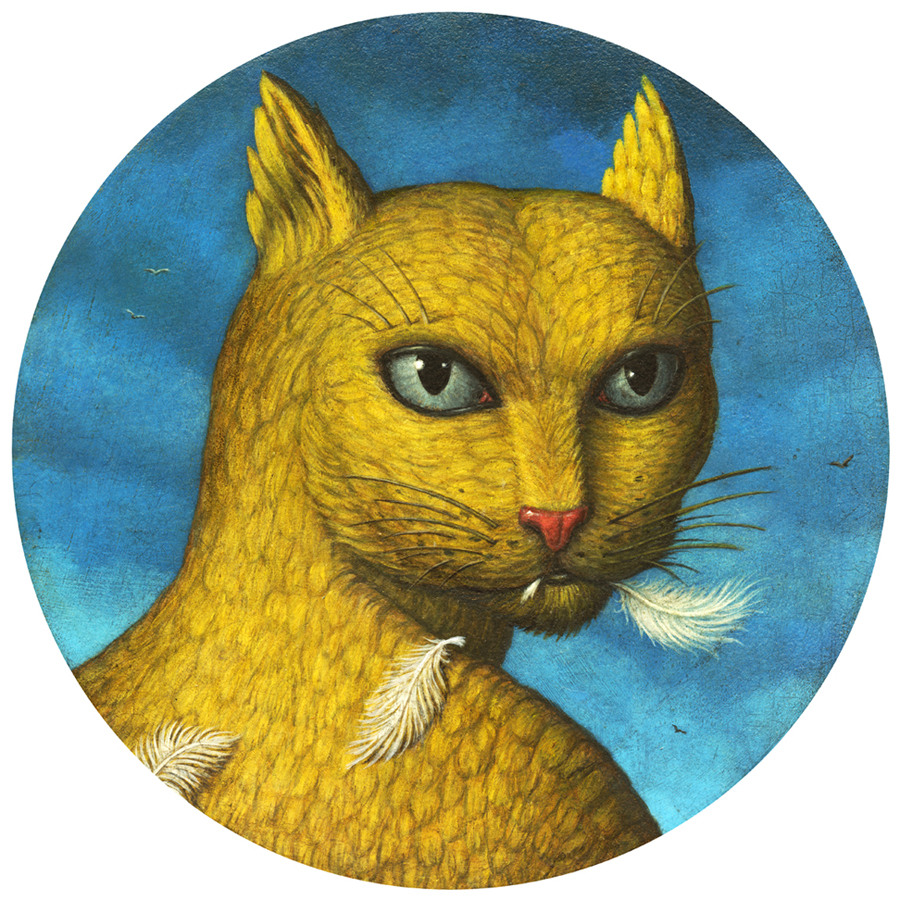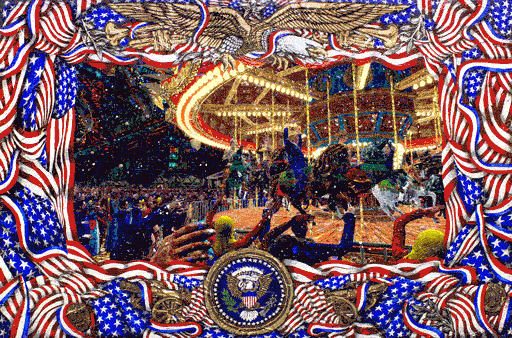
Of Place & Time: The Narrative Paintings of Andrew Hem
The paintings of Andrew Hem linger just left of reality. With his instantly recognizable style, Hem blends figurative painting and atmospheric landscapes, echoes of graffiti art and a deep understanding of color harmony. Rendering scenes both urban and rural, modern yet outside of time, he creates works that are a mix of realism and surrealism, personal truths and collective dreams.
Unsurprisingly, Hem’s unique style is born from an idiosyncratic background. His creative skills were incubated on the streets of Los Angeles, refined at ArtCenter College of Design in Pasadena and have evolved through far-flung travel and a career in flight. Growing up in the Culver City neighborhood of Los Angeles, Hem was surrounded by graffiti tags and gang lettering. As he moved into high school, he took an interest in the practice and would go out at night to tag buildings. After this hobby landed him with a brief stint in jail, Hem was scared away from the practice for good. He instead turned to painting as a profession. Over the years, he has worked in illustration at Disney, partnered with brands such as Adidas and Sony Pictures, and traveled the world to exhibit his work. Hem has even garnered an invitation from the White House, one of just ten artists included in a celebration of American Art.
Much like his unconventional background, Hem’s artistic process does not adhere to any one routine. “Every piece is different,” he explains, “so it’s hard to find a method that sticks and continue it over and over.” Depending on the project, Hem may begin with a sketch study, a digital rendering or, if the vision is clear enough, will go right to the canvas. “Not having a routine is probably why I still get so excited when I enter the studio after all these years,” he says.
His latest collection, which was shown through December at Dorothy Circus Gallery in London, is entitled Refuge and includes fifteen brand new artworks that Hem created during the pandemic. The title plays on a number of themes; it is a reference to his own past as well as a nod to art as a refuge, especially during times of strife. Hem, whose parents fled Cambodia during the Khmer Rouge genocide, was brought to the U.S. when he was just six months old. He was born at a refugee camp before a family in Richmond, Virginia sponsored Hem and his parents to come to the States.
“Since then my mom and dad have sponsored a few other families and brought them to the U.S. too,” explains Hem. “It’s amazing the life they have been able to create because of the opportunity. I know it makes my parents happy to have been able to complete a full circle. That’s one part of what I wanted to create with this new body of work.”
This idea of interconnection, of the cyclical nature of life, is apparent throughout this new collection of paintings. Each work conveys individual narratives, their strong sense of place and time a grounding force, but they are also interconnected. There are recurring details, shared experiences and repeating imagery. In “Upside Down,” a figure in a hoodie stands against a backdrop of fishing boats and mountains. In another painting, “Straight Fire,” a different hooded figure walks away from a scene of chaos, fire engines and falling power lines set against a sky billowing with smoke. Through Hem’s brush the hoodie becomes a symbol, a motif that appears in settings both urban and rural, seemingly western and eastern, a common thread that underscores the basic familiarity we share as humans, no matter our backgrounds.
Every piece is different…so it’s hard to find a method that sticks and continue it over and over.“
I wanted to show how people’s paths can be so unique in leaving home in order to create a more empathic view of the refugee.”
Hem plays on this idea of cultural fluidity through small details woven into each canvas. Clues are scattered like breadcrumbs—lettering on a T-shirt, a street sign, shadows of what might be St. Peter’s Basilica in Rome behind an incongruous boat of people. These places are just knowable enough. Whether they are scenes from Hem’s memory or his imagination is moot. The point is that we recognize pieces of our own story amidst an unfamiliar backdrop.
Within these painted narratives there is also an invitation. In “School Boy,” “All Blue,” “CP6,” and others, the brightly rendered characters look out, seeming to stare straight at their audience. Some are in groups, others alone, yet they draw us in with their eyes, inviting us to reflect on the refugee experience as well as the collective journeys we have each taken as humans. In paintings entitled “CP7,” “CP9,” and “Upside Down,” Hem paints a glossy jacket, its collar striped red and white. It is perhaps the same one, finding its way around the world, or maybe a different version of the same design. It is a nod to the way things travel in this globalized world, how we can access similar objects in such disparate places. It is this underlying connection that Hem emphasizes, an idea even more notable for works created during the pandemic lockdown, a time of intense isolation.
Hem and his wife returned from their honeymoon right as the country began to shut down in the wake of Covid-19. Upon their return, his wife, an ER doctor, was called to the front lines. Juggling her work-related exposure and a parent sick with cancer, they made the difficult decision to live separately for a period of time until more was known about the virus. “For one month I stayed in my studio and produced about half of the works in the show,” Hem says. The isolation of the moment being further compounded by forced separation, Hem turned to his work. “Art has always been a refuge for me,” he says. “Drawing has always kept me busy. It was my go-to all the way until I decided to make it a career.”
Hem’s environment during the development of “Refuge” helps to contextualize the body of work as a whole. He was not only considering the refugee experience, but his own displacement from home. There is not just a meditation on the fluidity of culture in an increasingly globalized world, but the fluidity of borders in the path of a virus, of the absence of true separation when it comes to our human vulnerabilities. Above all, Hem’s intention, he says, is to portray, “us as humans being in the same boat, but that we all come from different ships.”
Stereotypically, the news and media has portrayed the refugee in a singular way, as perhaps someone who traveled by boat or train. I myself came with my family to the US on a plane and know of so many other journeys that happened in many different ways.”
This is a notion both literal and allegorical. In Refuge, transport is a common throughline. Hem paints cars and trains, boats that idle in the water and ones that are paddled before a dazzling skyline. He renders vans in bright yellow and a crowded street of rickshaws. Bikes are shown in motion, streams of pink and red moving in their wake. It speaks to the universality of departure and change, but also of the different means of transit at our disposal. “I wanted to show how people’s paths can be so unique in leaving home in order to create a more empathic view of the refugee,” Hem says. “Stereotypically, the news and media has portrayed the refugee in a singular way, as perhaps someone who traveled by boat or train. I myself came with my family to the US on a plane and know of so many other journeys that happened in many different ways.” With Refuge, Hem seeks to “show how creative, resourceful and ultimately brave a person can be in leaving home for an unknown and hopefully brighter future.”
Hope, after two years of weathering a pandemic, can feel like an alien concept. Yet for Hem, it is the crux of this body of work. As Dorothy Circle Gallery writes about the series, “The characters portrayed are hugging and welcoming us, a symbol of closeness that has been forbidden and feared for months, to remind us who we are and where we come from, but above all, the strength of humanity that lies within the sharing of dreams and ideals.” There is not just hope to be found on the other side of disaster, there is also goodness that comes from seeking to weather it together.*
This article first appeared in Hi-Fructose Issue 62, which is sold out. Get our next issue by subscribing to Hi-Fructose here.
 In Marc Burckhardt’s paintings, the artist’s work tethers classical influences to contemporary comic and pop art. In a recent show at Paul Roosen Contemporary, “Fault Lines," his newer mythological explorations are shown. Burckhardt was last mentioned on cctvta.com here.
In Marc Burckhardt’s paintings, the artist’s work tethers classical influences to contemporary comic and pop art. In a recent show at Paul Roosen Contemporary, “Fault Lines," his newer mythological explorations are shown. Burckhardt was last mentioned on cctvta.com here. In Federico Solmi’s “video paintings,” the artist’s electrifying style comes to life, as he scans his paintings into a game engine. During Armory Show's 2019 edition, these particular works garnered much attention from passers-by who gravitated toward his political works. The artist's practice also includes acrylic painting, gold and silver leaf, and other materials.
In Federico Solmi’s “video paintings,” the artist’s electrifying style comes to life, as he scans his paintings into a game engine. During Armory Show's 2019 edition, these particular works garnered much attention from passers-by who gravitated toward his political works. The artist's practice also includes acrylic painting, gold and silver leaf, and other materials. The paintings of Brett Ferry, created using acrylics and oil on board, defy in both materials used and the components depicted. The blending of vibrant abstractions and natural forms feel like clashes of realities. The Australian artist’s works may deceive and appear as digital paintings, yet this simply part of the author’s charge.
The paintings of Brett Ferry, created using acrylics and oil on board, defy in both materials used and the components depicted. The blending of vibrant abstractions and natural forms feel like clashes of realities. The Australian artist’s works may deceive and appear as digital paintings, yet this simply part of the author’s charge. Serena Cole blends watercolors, colored pencil, and other materials in her stirring portraits, deftly adding provocative elements in the contours of her subjects. In recent works, the artist "considers each piece an avatar of herself," a recent statement says, with self-portraits that reflect on different experiences of being a woman today.
Serena Cole blends watercolors, colored pencil, and other materials in her stirring portraits, deftly adding provocative elements in the contours of her subjects. In recent works, the artist "considers each piece an avatar of herself," a recent statement says, with self-portraits that reflect on different experiences of being a woman today.
